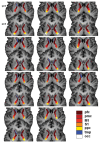Two-dimensional population map of cortical connections in the human internal capsule
- PMID: 17152053
- PMCID: PMC7610899
- DOI: 10.1002/jmri.20810
Two-dimensional population map of cortical connections in the human internal capsule
Abstract
Purpose: To exploit diffusion imaging tractography to produce a two-dimensional (xy) probabilistic population map of the cortical connections within the human internal capsule (IC).
Materials and methods: Diffusion tensor imaging (DTI) was carried out on 11 healthy volunteers. We parceled an axial section of the IC according to its connections to the prefrontal, premotor, primary motor, primary somatosensory, posterior parietal, and occipital cortices using our locally developed probabilistic algorithm.
Results: A consistent topographical organization was generated that was consistent with our anatomical knowledge of the IC. In addition, our study shows that in humans the anterior half of the IC is occupied by the prefrontal cortex.
Conclusion: This map may be of clinical use for correlating neurological deficit with hemispheric lesions, particularly those that affect sensorimotor function.
Figures




References
-
- Dejerine J, Déjerine-Klumpke A. Anatomie des centres nerveaux. Paris: Rueff; 1901. p. 816.
-
- Hardy TL, Bertrand G, Thompson CJ. The position and organization of motor fibers in the internal capsule found during stereotactic surgery. Appl Neurophysiol. 1979;42:160–170. - PubMed
-
- Hardy TL, Bertrand G, Thompson CJ. Organization and topography of sensory responses in the internal capsule and nucleus ventralis caudalis found during stereotactic surgery. Appl Neurophysiol. 1980;42:335–351. - PubMed
-
- Englander RN, Netsky MG, Adelman LS. Location of human pyramidal tract in the internal capsule: anatomic evidence. Neurology. 1975;25:823–826. - PubMed
-
- Leon SF, Pradilla AG. Antero-posterior localization of the pyramidal tract in the internal capsule in a living patient. Invest Clin. 1994;35:67–75. - PubMed
MeSH terms
Grants and funding
LinkOut - more resources
Full Text Sources

